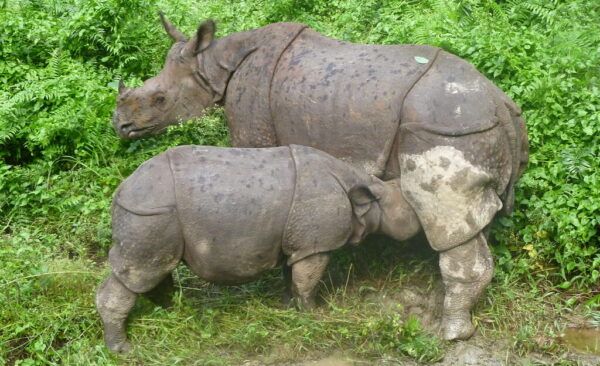The greater one-horned rhinoceros (Rhinoceros unicornis), also known as the Indian rhino, is one of the three Asian rhinos. It is the largest of all Asian rhinos and second only to the white rhino in size among all rhino species. The greater one-horned rhino has a single black horn about 8-25 inches long and a grey-brown hide with skin folds, which gives it an armor-plated appearance.
Physical Traits
The greater one-horned rhino is identified by its single black horn, about 8-25 inches long, and a grey-brown hide with skin folds, which gives it an armor-plated appearance. Males are larger than females and weigh up to 4,000 to 6,600 pounds (2,200 to 3,000 kg). They can be up to 12.5 feet (3.8 m) long and 5 feet (1.5 m) tall at the shoulder.
Life Span
The average life span of a greater one-horned rhino in the wild is 30 years; however, they have been known to live up to 40 years in captivity.
Habitat
The greater one-horned rhino lives in northern India and southern Nepal, in riverine (floodplain) grasslands and adjacent woodland areas near rivers or swamps. They prefer areas with tall grasses for cover from predators such as tigers or leopards.
Diet
Greater one-horned rhinos are herbivores that eat grasses, fruit, leaves, shrub, and tree branches. They have a folding upper lip that can grasp leaves and twigs but fold it back when not feeding so they don’t get scratched by thorns or other sharp objects while walking through dense vegetation.
Reproduction
Greater one-horned rhinos reach sexual maturity between 5–7 years old for females and 7–10 for males. The gestation period lasts 15–16 months, after which females give birth to a single calf every 2–4 years until they reach their mid-20s when fertility declines significantly due to age-related factors like hormonal changes or health issues like arthritis or obesity caused by poor diet or lack of exercise.
Conservation Status
The greater one-horned rhino is listed as Vulnerable on the IUCN Red List due to habitat loss from human activities such as agricultural expansion and infrastructure development, as well as poaching for their horns which are believed by some cultures to have medicinal properties even though there is no scientific evidence supporting this claim. The population has increased from around 200 individuals in 1975 to over 3200 individuals today thanks to conservation efforts such as anti-poaching patrols, translocation programs, habitat protection measures, etc.
Interesting Facts
• The greater horned Rhino is also known as the ‘Indian Rhinoceros’ because it was first described in India.
• Its scientific name, ‘Rhinoceros unicorns, ‘ means’ one horned nose.’

